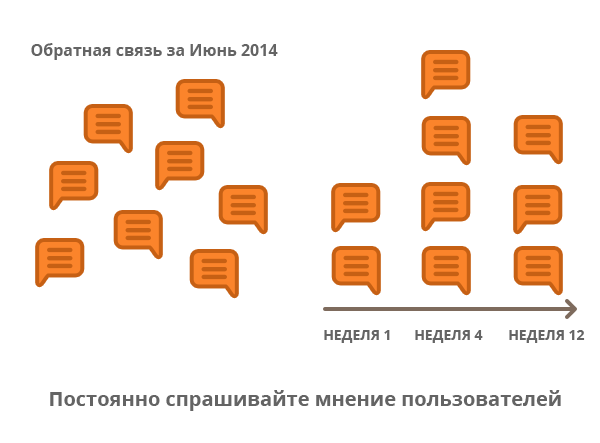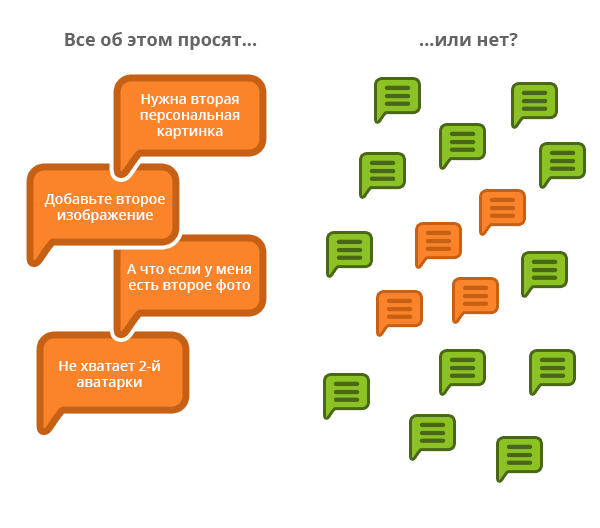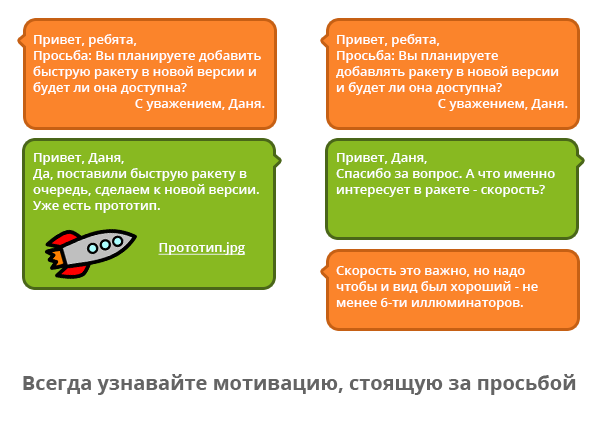5 errors in user feedback
- Transfer

Today, the point is to listen to feedback from all visitors, almost absent. At least you should not try to get all the information at once.
At the starting stage of a new project, especially if the management of a product is carried out not so long ago, there is a great temptation to find out the opinion of all users on a particular issue. But more often than not, such haste is erroneous. In addition to rush, most specialists involved in the promotion of certain products make 5 major mistakes that are repeated again and again. The presence of many feedback services makes receiving information from users an extremely simple process - however, do not get carried away with receiving it for any reason. weWe have prepared for you five tips for using feedback from potential customers.
1. DO NOT APPLY TO ALL USERS IMMEDIATELY

Examining the opinions of all users at once, you ignore the behavioral specifics of each of them. You must admit that for the purposes of product management it is foolish to put together those who came to you a couple of days ago and those who have been working with you for many years. Those who use your product every day and those who log in once a month to update billing data.
Solving this problem is not so difficult. Break users into segments, for example:
If the goal is to improve ways to attract new visitors, then you need to interview those who have signed up relatively recently.
If you need to refine one or another functional - contact those who use it.
Want to understand why customers do not use a particular service? Interview those who do not use it.
If you need to "test" the product and establish problem areas, then establish contact only with active users who constantly use all the functions of the product.
2. MAKE FEEDBACK

The essence of the feedback assumes that the product developer himself initiates its receipt. This means that after the need for feedback has appeared, you need to wait a while and do nothing, receiving and analyzing feedback. To compensate for this, you accumulate and ask users even more questions, after which they wait a long time for answers. The reaction to each review will be especially stupid, instead of having to wait for all the data and analyze its entirety.
The problem here has two sides: firstly, information from users comes not at the moment when it is needed, and secondly, user reviews come only when you ask them a question. This is how you can miss the moment when the product requires immediate improvement.
Solution: Conduct customer surveys regularly. The easiest, but very effective way is to ask the user to send your feedback and suggestions, for example, on the 30th, 60th, 120th, 365th day of using the product. Modern services allow you to carry out such a setup in a couple of minutes, and a similar approach pays off in just a couple of days.
A more complicated way is to obtain feedback on the frequency of use of individual functions. For example, if your product has a calendar, then you can ask a question to users after the 15th, 30th and 60th calls to a separate function - this is how you can achieve more meaningful and structured feedback: when you use it for the first time, a person will tell you that it’s not clear on the 15th what he would like to change, on the 60th what restrictions your product has.
3. SEPARATE FEEDBACK AND FREE SUBSCRIBER REVIEWS

It is easy to trace the connection with advice number 1. Of course, the easiest way to consider the entire set of reviews without taking into account the type of subscription. In general, this can be done up to a certain threshold (for example, for customers who pay 500-3500 rubles per month), however, the difference between requests from free and paid subscribers is still significant. Users of free services can certainly improve your free packages, but hardly your business is focused on just that. Most often, free packages are created to attract new users, so that later they switch to a paid subscription. Do not pay attention to reviews of the following type:
I’ll switch to a paid subscription if ...
I’ll switch to a paid subscription when ...
Accepting promises in business is not productive. Pay attention to what is really happening.
So, some tips for solving:
To improve the terms of use of products for paid subscribers, refer only to paid subscribers.
To find out the motivation for switching from a free to a paid subscription, refer only to switched users.
To improve free packages, contact only free users, but try not to follow their lead - such users do not bring you profit, but, most likely, they simply request more free features.
4. DON'T LISTEN TO A NOISY MINORITY

A common joke among marketers is that the plural of the word “opinion” is not “data” at all. This, of course, does not mean that the opinion of one client is necessarily useless. But if one day 10 users turn to you with a request to improve, for example, calendar management, then you do not need to immediately start a project to finalize the product. First you need to find out how much these ten clients represent a common opinion by polling all users of this functionality.
Solution: each user feedback received should be perceived primarily as a hypothesis that needs to be verified. But even after you find that all users agree, you should not immediately begin the implementation phase of the proposal.
A more thorough analysis should be carried out - this is what our last advice is.
5. DO NOT THINK BY DEFAULT THAT ALL USERS OFFER THE CORRECT SOLUTION
 rocket To
rocket To paraphrase Confucius a bit:
When a customer points to the moon, a naive product manager examines his finger.
Henry Ford’s notorious consumer story (“If I asked people what they want, they would ask for a faster horse”) is often used as an excuse to ignore customer wishes. But not in our case: if a client needs a horse faster, then in fact his key requirement is speed of movement. It's time to sit down and think about how to bring it to life. In a previous example with 10 people, we talked about their request to improve calendar management. You can immediately sit down and adjust the shape and content of the product, but very often this makes no sense. Having interviewed all users, we will most likely find out that the point is not in the complexity of the calendar management form, but in the frequency of its use.
Solution: it is necessary to remember that each user request is a complex combination of the client’s personal skills, the degree of his familiarity with the product, as well as the peculiarities of perceiving problems and having imagination. The client does not know your vision of the product and does not represent the complexity of the implementation of a service. That is why the client’s opinion is not a guide to action, but only an opportunity to look at a problem from a different point of view and find a solution that will be beneficial for you and convenient for users.
Of course, many of the advice your customers will combine perfectly with other properties of the product and fit perfectly into its concept. In such cases, it is necessary to include an intuitive understanding of what you offer users in order to easily find ways to improve the product with them.
We hope that the described errors will help you build effective communication with your users and improve your service.
Good feedback and cool products!
Yes, and come to us, leave your feedback. Together we will build a system of communication with users .
